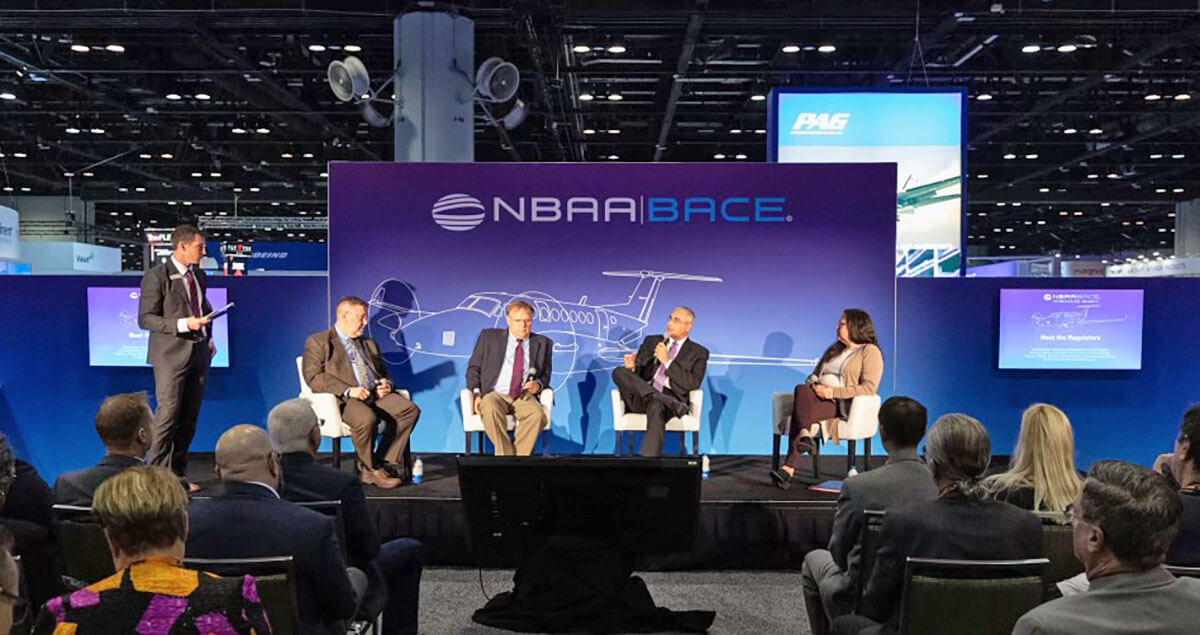FAA Makes Highly Anticipated Training Announcement at NBAA-BACE

Oct. 18, 2022
The ever-popular Meet the Regulators session returned to the 2022 NBAA Business Aviation Convention & Exhibition (NBAA-BACE) with four top FAA leadership representatives sharing the latest updates of the regulatory landscape, including Part 135 training, airman medicals, letters of authorization (LOA) and more.
A standing room only crowd participated in the town hall Q&A style panel.
David Boulter, the FAA’s associate administrator for aviation safety, provided an update on efforts to standardize Part 135 training programs as a federal register notice on a Gulfstream V training program was published today, with public comment opening later this week. He thanked NBAA and its members for their efforts in the standardized training program.
“If we didn’t have industry support in this, it wouldn’t happen,” Boulter said.
Boulter explained the GV standardized program is just the first of a broad-scope initiative to standardize training programs for many aircraft types and said voluntary adoption of standardized training programs “will move Part 135 training to a new level,” as the industry moves from what he calls the “practice, practice, check” training method to a more realistic, scenario-based training method.
The Training Standardization Working Group (TSWG) was launched in 2020 to provide advice and recommendations to the Aviation Rulemaking Advisory Committee (ARAC) on the most effective ways to standardize check pilot qualification, flight instructor qualification and Part 135 air carrier training curricula provided by Part 142 training center.
Representatives from training centers, operators, aircraft manufacturers and industry associations make up the TSWG, with several NBAA committee members actively participating. NBAA’s Brian Koester, CAM, director of flight operations and regulations, is the TSWG industry co-chair.
Medical Issues
Dr. Susan Northrup, the FAA’s federal air surgeon, discussed how the agency addresses treatment for various conditions, included ADD and ADHD.
“We use a science-based approach and look at the diagnoses and the data behind treatment methods,” said Northrup, adding the FAA uses a safety management system approach. More information regarding attention deficit disorder treatments should be available within in a year.
She also shared efforts to streamline special issuance airman medicals, utilizing local aviation medical examiners more effectively and providing pilots better tools for obtaining medicals.
Operational Updates
Giovanni Dipierro, FAA’s manager of the agency’s runway safety program, shared runway incursion data and ongoing education and outreach initiatives, encouraging pilots to ask ATC for clarifications when instructions are in doubt. Miscommunication is often a cause of runway incursions.
Wesley Mooty, FAA’s acting deputy executive director of Flight Standards Service, shared efforts to use remote technology in surveillance activities, including pilot line checks.
“It’s not that all surveillance will go to remote technology, but it is a tool where inspectors can determine if remote technology can be used for the surveillance task,” Mooty said. “We do have the pandemic to thank for that, for motivating us to find other ways to do it [surveillance].”
The FAA also is working to share resources across different field offices to address LOA requests and other tasks, Mooty explained. The new Operational Approval Portal System provides operators with a tracking mechanism for LOA requests and operators are encouraged to ask their inspectors for access to the system.
Meanwhile, the FAA launched processes to streamline LOA issuance for new aircraft in the past year. Mooty reported positive results so far from the streamlined LOA process.
Any person who attends an NBAA convention, conference, seminar or other program grants permission to NBAA, its employees and agents (collectively "NBAA") to record his or her visual/audio images, including, but not limited to, photographs, digital images, voices, sound or video recordings, audio clips, or accompanying written descriptions, and, without notifying such person, to use his or her name and such images for any purpose of NBAA, including advertisements for NBAA and its programs.
Related Articles
January 31, 2024
DOT Waiver Provides Welcome Relief for Presidential Election Campaign Charters
Jan/Feb 2024
FAA Part 135/Part 380 Notice of Intent Sparks Concerns
November 6, 2023
FAA Issues Notice on Runway Obstacle Analysis Products for Part 135 Operators
October 13, 2023


 International Business Aviation Council Ltd.
International Business Aviation Council Ltd.